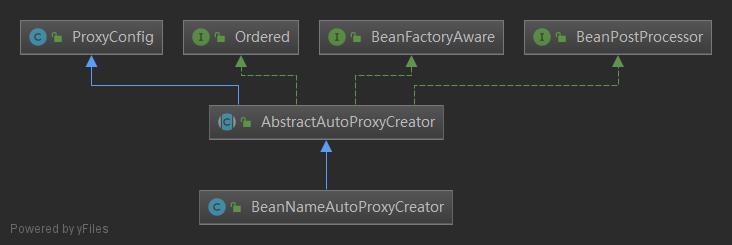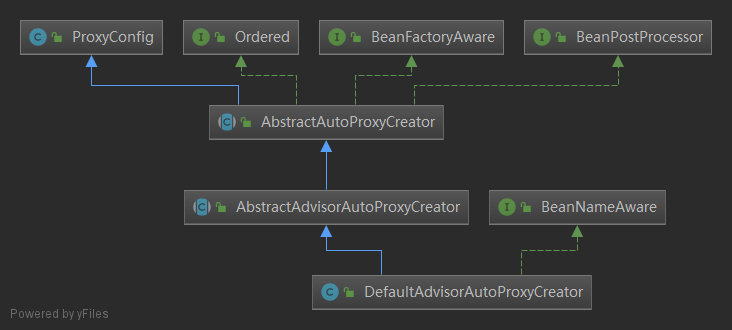重拾-Spring AOP-自动代理
概述
在上一篇 重拾-Spring AOP 中我们会发现 Spring AOP 是通过类 ProxyFactoryBean 创建代理对象,其有个缺陷就是只能代理一个目标对象 bean, 当代理目标类过多时,配置文件臃肿不方便管理维护,因此 Spring 提供了能够实现自动创建代理的类 BeanNameAutoProxyCreator , DefaultAdvisorAutoProxyCreator ;下面我们看下二者是如何实现自动代理的。
BeanNameAutoProxyCreator
BeanNameAutoProxyCreator 是通过判断当前 bean name 是否匹配,只有匹配的 bean 才会创建代理。
使用示例
- Spring xml 配置
<bean id="userService" class="org.springframework.aop.UserServiceImpl" />
<bean id="demoService" class="org.springframework.aop.DemoServiceImpl" />
<bean id="userBeforeAdvice" class="org.springframework.aop.UserBeforeAdvice" />
<bean id="userAfterAdvice" class="org.springframework.aop.UserAfterAdvice" />
<bean id="beanNameAutoProxyCreator" class="org.springframework.aop.framework.autoproxy.BeanNameAutoProxyCreator">
<!-- 配置要代理的 bean -->
<property name="beanNames">
<list>
<value>userService</value>
<value>demoService</value>
</list>
</property>
<!-- 配置 interceptor, advice, advisor -->
<property name="interceptorNames">
<list>
<value>userAfterAdvice</value>
<value>userBeforeAdvice</value>
</list>
</property>
</bean>
- 测试
ClassPathXmlApplicationContext ctx = new ClassPathXmlApplicationContext("/org/springframework/aop/aop.xml");
UserService userService = (UserService) ctx.getBean("userService");
userService.say();
DemoService demoService = (DemoService) ctx.getBean("demoService");
demoService.demo();
- 运行结果
do before advice .... do say method do after return advice .... do before advice .... do demo. do after return advice ....
实现分析
类结构

如上图 BeanNameAutoProxyCreator 类结构可以看出,其实现了接口 BeanPostProcessor ; 那么我们可以大概猜测出其自动代理的实现原理与自动注入类似,都是在 bean 实例化后进行特殊的处理,下面就让我们看下源码验证下吧。
分析
public Object postProcessAfterInitialization(Object bean, String name) throws BeansException {
// Check for special cases. We don't want to try to autoproxy a part of the autoproxying
// infrastructure, lest we get a stack overflow.
if (isInfrastructureClass(bean, name) || shouldSkip(bean, name)) {
logger.debug("Did not attempt to autoproxy infrastructure class '" + bean.getClass() + "'");
return bean;
}
TargetSource targetSource = getTargetSource(bean, name);
Object[] specificInterceptors = getInterceptorsAndAdvisorsForBean(bean, name);
// proxy if we have advice or if a TargetSourceCreator wants to do some
// fancy stuff such as pooling
if (specificInterceptors != DO_NOT_PROXY || !(targetSource instanceof SingletonTargetSource)) {
// handle prototypes correctly
// 获取容器中配置的 advisors
Advisor[] commonInterceptors = resolveInterceptorNames();
List allInterceptors = new ArrayList();
if (specificInterceptors != null) {
allInterceptors.addAll(Arrays.asList(specificInterceptors));
if (commonInterceptors != null) {
if (this.applyCommonInterceptorsFirst) {
allInterceptors.addAll(0, Arrays.asList(commonInterceptors));
}
else {
allInterceptors.addAll(Arrays.asList(commonInterceptors));
}
}
}
if (logger.isInfoEnabled()) {
int nrOfCommonInterceptors = commonInterceptors != null ? commonInterceptors.length : 0;
int nrOfSpecificInterceptors = specificInterceptors != null ? specificInterceptors.length : 0;
logger.info("Creating implicit proxy for bean '" + name + "' with " + nrOfCommonInterceptors +
" common interceptors and " + nrOfSpecificInterceptors + " specific interceptors");
}
ProxyFactory proxyFactory = new ProxyFactory();
// copy our properties (proxyTargetClass) inherited from ProxyConfig
proxyFactory.copyFrom(this);
if (!getProxyTargetClass()) {
// Must allow for introductions; can't just set interfaces to
// the target's interfaces only.
// 添加设置代理的接口
Class[] targetsInterfaces = AopUtils.getAllInterfaces(bean);
for (int i = 0; i < targetsInterfaces.length; i++) {
proxyFactory.addInterface(targetsInterfaces[i]);
}
}
for (Iterator it = allInterceptors.iterator(); it.hasNext();) {
Advisor advisor = GlobalAdvisorAdapterRegistry.getInstance().wrap(it.next());
// 添加 advisor
proxyFactory.addAdvisor(advisor);
}
proxyFactory.setTargetSource(getTargetSource(bean, name));
// 创建代理对象,依旧采用的 jdk 动态代理; 因为上面设置了代理的 interface
return proxyFactory.getProxy();
}
else {
return bean;
}
}
protected Object[] getInterceptorsAndAdvisorsForBean(Object bean, String beanName) {
if (this.beanNames != null) {
// bean name 包含在配置的名称列表中,说明需要代理
if (this.beanNames.contains(beanName)) {
return PROXY_WITHOUT_ADDITIONAL_INTERCEPTORS;
}
for (Iterator it = this.beanNames.iterator(); it.hasNext();) {
String mappedName = (String) it.next();
// bean name 匹配通配符,说明需要代理
if (isMatch(beanName, mappedName)) {
return PROXY_WITHOUT_ADDITIONAL_INTERCEPTORS;
}
}
}
// 说明 bean 不需要代理
return DO_NOT_PROXY;
}
protected boolean isMatch(String beanName, String mappedName) {
// bean name 匹配通配符
return (mappedName.endsWith("*") && beanName.startsWith(mappedName.substring(0, mappedName.length() - 1))) ||
(mappedName.startsWith("*") && beanName.endsWith(mappedName.substring(1, mappedName.length())));
}
从 BeanNameAutoProxyCreator 的源码大概总结其自动代理流程:
- 判断当前 bean name 是否匹配配置
- 加载配置的 advisor, 也就是配置的 interceptorNames
- 采用 jdk 动态代理创建 bean 的代理对象
DefaultAdvisorAutoProxyCreator
DefaultAdvisorAutoProxyCreator 会搜索 BeanFactory 容器内部所有可用的 Advisor ; 并为容器中匹配的 bean 创建代理。 在上一篇 重拾-Spring AOP 中我们知道 Spring AOP 会默认创建实例为 DefaultPointcutAdvisor 的 Advisor ; 那么在分析 DefaultAdvisorAutoProxyCreator 之前,我们看下 Spring AOP 还为我们提供了哪些内置的 Advisor 。
NameMatchMethodPointcutAdvisor
NameMatchMethodPointcutAdvisor 是按 method name 匹配,只有当目标类执行方法匹配的时候,才会执行 Advice
public class NameMatchMethodPointcut extends StaticMethodMatcherPointcut {
// 配置拦截的 method name
private String[] mappedNames = new String[0];
public boolean matches(Method m, Class targetClass) {
for (int i = 0; i<this.mappedNames.length; i++) {
String mappedName = this.mappedNames[i];
// 目标方法是否与配置的 method name 相等;或者匹配通配符
if (mappedName.equals(m.getName()) || isMatch(m.getName(), mappedName)) {
return true;
}
}
return false;
}
// 是否以 * 开头或结束并匹配
protected boolean isMatch(String methodName, String mappedName) {
return (mappedName.endsWith("*") && methodName.startsWith(mappedName.substring(0, mappedName.length() - 1))) ||
(mappedName.startsWith("*") && methodName.endsWith(mappedName.substring(1, mappedName.length())));
}
}
RegexpMethodPointcutAdvisor
RegexpMethodPointcutAdvisor 是按照正则表达式匹配方法,能够精确定位到需要拦截的方法。
public class RegexpMethodPointcut extends StaticMethodMatcherPointcut implements ClassFilter {
public boolean matches(Method m, Class targetClass) {
// TODO use target class here?
// 拼接表达式
String patt = m.getDeclaringClass().getName() + "." + m.getName();
for (int i = 0; i < this.compiledPatterns.length; i++) {
// 正则匹配
boolean matched = this.matcher.matches(patt, this.compiledPatterns[i]);
if (logger.isDebugEnabled()) {
logger.debug("Candidate is: '" + patt + "'; pattern is " + this.compiledPatterns[i].getPattern() +
"; matched=" + matched);
}
if (matched) {
return true;
}
}
return false;
}
public boolean matches(Class clazz) {
// TODO do with regexp
return true;
}
public ClassFilter getClassFilter() {
return this;
}
}
使用示例
- xml 配置
<beans>
<bean id="userService" class="org.springframework.aop.UserServiceImpl" />
<bean id="demoService" class="org.springframework.aop.DemoServiceImpl" />
<bean id="userBeforeAdvice" class="org.springframework.aop.UserBeforeAdvice" />
<bean id="userAfterAdvice" class="org.springframework.aop.UserAfterAdvice" />
<!-- 按方法名称匹配 -->
<bean id="nameMatchMethodPointcutAdvisor" class="org.springframework.aop.support.NameMatchMethodPointcutAdvisor">
<property name="mappedNames">
<!-- 匹配 save 开头的方法 -->
<value>save*</value>
</property>
<property name="advice">
<ref bean="userBeforeAdvice" />
</property>
</bean>
<bean id="regexpMethodPointcutAdvisor" class="org.springframework.aop.support.RegexpMethodPointcutAdvisor">
<property name="pattern">
<!-- 匹配以 del 开头的方法 -->
<value>org.springframework.aop.*.del*.*</value>
</property>
<property name="advice">
<ref bean="userAfterAdvice" />
</property>
</bean>
<bean class="org.springframework.aop.framework.autoproxy.DefaultAdvisorAutoProxyCreator" />
</beans>
- 测试
ClassPathXmlApplicationContext ctx = new ClassPathXmlApplicationContext("/org/springframework/aop/aop.xml");
UserService userService = (UserService) ctx.getBean("userService");
userService.saveUser();
userService.delUser();
DemoService demoService = (DemoService) ctx.getBean("demoService");
demoService.saveDemo();
demoService.delDemo();
- 测试结果
do before advice .... do save user ...... do del user ...... do after return advice .... do before advice .... do save demo ...... do del demo ...... do after return advice ....
从测试结果可以看出,通过配置不同 Advisor 匹配不同的 Method 采用相应的 Advice 进行处理。
实现分析
类结构

从上图 DefaultAdvisorAutoProxyCreator 类结构,我们知道其实现与 BeanNameAutoProxyCreator 类似;都是通过实现接口 BeanPostProcessor 在 bean 完成实例化后进行自动代理处理。
分析
因 DefaultAdvisorAutoProxyCreator 和 BeanNameAutoProxyCreator 都继承了类 AbstractAutoProxyCreator ,所以从源码中我们可以发现二者都重写了方法 getInterceptorsAndAdvisorsForBean ,也就是在获取当前 bean 所匹配的 Advisor 逻辑不一样之外其他处理一致; 那么下面针对 DefaultAdvisorAutoProxyCreator 的实现我们主要看下方法 getInterceptorsAndAdvisorsForBean 的处理。
protected Object[] getInterceptorsAndAdvisorsForBean(Object bean, String name) {
// 查找与当前 bean 匹配的 advisor
List advices = findEligibleAdvisors(bean.getClass());
if (advices.isEmpty()) {
return DO_NOT_PROXY;
}
// 对 advisor 集合排序
advices = sortAdvisors(advices);
return advices.toArray();
}
- 查找匹配的 Advisor
protected List findEligibleAdvisors(Class clazz) {
// 查找当前容器中所有定义的 advisor
List candidateAdvice = findCandidateAdvisors();
List eligibleAdvice = new LinkedList();
for (int i = 0; i < candidateAdvice.size(); i++) {
// Sun, give me generics, please!
Advisor candidate = (Advisor) candidateAdvice.get(i);
// 判断 bean 是否可以应用 advisor
if (AopUtils.canApply(candidate, clazz, null)) {
// 将 advisor 添加到匹配的集合中
eligibleAdvice.add(candidate);
logger.info("Candidate Advice [" + candidate + "] accepted for class [" + clazz.getName() + "]");
}
else {
logger.info("Candidate Advice [" + candidate + "] rejected for class [" + clazz.getName() + "]");
}
}
return eligibleAdvice;
}
- 获取容器中所有的 Advisor
protected List findCandidateAdvisors() {
if (!(getBeanFactory() instanceof ListableBeanFactory)) {
throw new IllegalStateException("Cannot use DefaultAdvisorAutoProxyCreator without a ListableBeanFactory");
}
ListableBeanFactory owningFactory = (ListableBeanFactory) getBeanFactory();
// 从容器中查找所有 bean 定义 type 为 Advisor 的 bean name
String[] adviceNames = BeanFactoryUtils.beanNamesIncludingAncestors(owningFactory, Advisor.class);
List candidateAdvisors = new LinkedList();
for (int i = 0; i < adviceNames.length; i++) {
String name = adviceNames[i];
if (!this.usePrefix || name.startsWith(this.advisorBeanNamePrefix)) {
// 获取 advisor 实例
Advisor advisor = (Advisor) owningFactory.getBean(name);
candidateAdvisors.add(advisor);
}
}
return candidateAdvisors;
}
- 判断 bean 是否匹配 Advisor
public static boolean canApply(Advisor advisor, Class targetClass, Class[] proxyInterfaces) {
if (advisor instanceof IntroductionAdvisor) {
return ((IntroductionAdvisor) advisor).getClassFilter().matches(targetClass);
}
else if (advisor instanceof PointcutAdvisor) {
PointcutAdvisor pca = (PointcutAdvisor) advisor;
// 通过 advisor 的 pointcut 判断 bean 是否匹配
return canApply(pca.getPointcut(), targetClass, proxyInterfaces);
}
else {
// It doesn't have a pointcut so we assume it applies
return true;
}
}
public static boolean canApply(Pointcut pc, Class targetClass, Class[] proxyInterfaces) {
// 类是否匹配
if (!pc.getClassFilter().matches(targetClass)) {
return false;
}
// 判断类中的 method 是否匹配
// 获取类下所有的method
Method[] methods = targetClass.getMethods();
for (int i = 0; i < methods.length; i++) {
Method m = methods[i];
// If we're looking only at interfaces and this method
// isn't on any of them, skip it
if (proxyInterfaces != null && !methodIsOnOneOfTheseInterfaces(m, proxyInterfaces)) {
continue;
}
// 执行 pointcut 的 method match
if (pc.getMethodMatcher().matches(m, targetClass))
return true;
}
return false;
}
从 DefaultAdvisorAutoProxyCreator 的源码分析,可知其自动代理流程大概如下:
Advisor Advisor
小结
从 BeanNameAutoProxyCreator , DefaultAdvisorAutoProxyCreator 二者的实现可以看出其相同点
BeanPostProcessor Advisor
二者的不同点在于:
- 前者是基于 bean name 判断是否判断,后者是通过
Advisor内部的Ponitcut匹配判断 - 前者的
Advisor是用户配置的,后者是容器中所有匹配的Advisor











![[HBLOG]公众号](http://www.liuhaihua.cn/img/qrcode_gzh.jpg)

